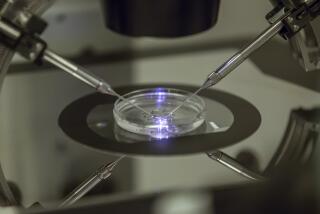Could Early Genetic Errors Cause Twins? : Science: A new and controversial theory suggests that identical twins may be the result of an embryo trying to rid itself of ‘abnormal’ cells.
- Share via
BAR HARBOR, Me. — Strange genetic accidents that perturb early steps in the growth of a human embryo may be what creates identical twins, a genetic scientist suggests.
Twins, says Dr. Judith G. Hall, may result when a rapidly growing embryo senses that something unusual or abnormal has happened to one or a few of its cells. It then tries to shove the “different” cells aside, like a baby bird tipping a weaker sibling out of the nest.
Most often it succeeds, eliminating the weakened clump of cells, which get absorbed and simply disappear, Hall said. But in a small percentage of cases the discarded clump of cells survives, overcomes the damage and goes on to normal birth. The result in such cases is apparently identical, normal twins.
Hall, from the University of British Columbia, emphasized she was talking about monozygotic (identical) twins, not dizygotic (fraternal) twins. Fraternal twins are known to arise when two eggs are released from the ovaries, get fertilized and implant together in the womb. In contrast, identical twins start out as a single embryo, split, and then develop as separate individuals in the womb.
The result is that fraternal twins do not have exactly the same set of genes, while identical twins share a duplicated set of genes. Identical twins, of course, are always of the same sex and usually look very much alike.
What Hall is finding, however, is that identical twins are seldom really identical; they differ in small ways, some of which are traceable to genetic events that perhaps caused twinning in the first place. And in some rare cases, she added, identical twins can differ in big ways.
“My hypothesis is that all (monozygotic) twins are not identical,” Hall said during a symposium here at the Jackson Laboratory. “Something led to the two separate embryos developing. So we’re looking for signs of discordance,” genetic differences, “and they are everywhere.”
“There is disease after disease in which one twin is normal and the other isn’t,” Hall said. So she suspects that “some cellular error causes twinning.”
The important point, then, she said, is that such differences may provide a fundamental explanation for the phenomenon of identical twinning. Until now “we had no idea why twinning occurs.”
Fortunately, she added, the differences between identical twins are seldom very pronounced, and usually there are no signs of abnormality in either twin. But it is the study of genetic diseases which is beginning to show what happens in twinning.
Although Hall finds much compelling evidence for her hypothesis that early genetic errors cause twinning, other researchers are not yet convinced. Dr. Walter Nance, chairman of human genetics at the Medical College of Virginia, for example, said: “I don’t see a good way for proving it. And useful hypotheses are those that can be disproved.”
Nance added that Hall’s idea is “interesting and exciting to look at,” but he doesn’t see any good test that would confirm or disprove it.
Human geneticist Douglas Wallace, from Emory University in Atlanta, added that Hall’s hypothesis seems reasonable, and may even be accurate, “but there is far too little data at present” to warrant firm conclusions.
If it turns out that her idea is correct, Hall explained, it will be important to continue studying events that occur very early in gestation. She is convinced the genetic damage that leads to twinning appears very early in the life of the embryo.
“There is a very clear time range when this has to happen,” she said. “Twinning happens before Day 11” of gestation. After that, the fetus begins developing numerous different kinds of tissues, so the fetus then gets used to having tissues around that look slightly “different” from each other.
But if the genetic damage occurs early enough--either coming in with egg or sperm, or resulting from accidental chromosome arrangements--the growing embryo may be able to sense that something is wrong and try to discard a clump of cells containing the error.
In fact, there is one condition, called the “disappearing twin syndrome,” Hall said, in which twins are detected quite early in pregnancy, but within a few months one of them has disappeared from the womb. In such cases, genetic damage might have been so severe that life was not possible and the fetus was absorbed.
Such a fetus may be saved, however, because there are mechanisms inside cells capable of repairing genetic damage. Or, alternatively, the “good” cells in the fetus may “overgrow” the sick cells and go on to produce a viable individual. So instead of simply disappearing, the discarded clump of cells may get repaired and resume growing into a whole new fetus, a twin of the original.
Hall also pointed out that this seems to occur in all human populations. The rate of identical twins being born is about once in each 150 pregnancies around the world. In contrast, the rate of fraternal twins being born varies widely, with very few being seen in Japan, and large numbers being seen in Africa.
What may explain part of that difference, Hall said, is that in Japan there were long-held prejudices against twins of any kind.
“Historically it was a very bad omen to have twins,” she said. Years ago “the mother and her twins were killed,” which means that families which tended to have fraternal twins were gradually reduced in the population. This may have significantly reduced the numbers of women who have naturally high levels of the egg-releasing hormone, gonadotropin.
More recently the situation has changed, Hall said, and “now in Japan there is a lot of support for twins” because of that history.
“But there is still an underlying taboo,” perhaps exemplified by twins being segregated, enrolled together in special high schools.





